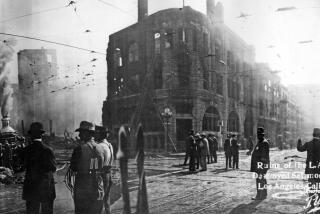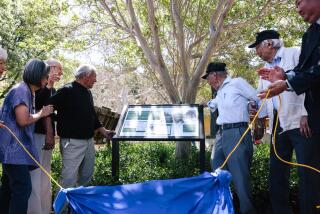50 years later, Alcatraz escapees’ tale still captivates
SAN FRANCISCO — There was the leather pouch, crafted in prison, that according to family lore may have contained a message about the escapees’ hide-out.
There were the flowers, which arrived reliably on special occasions at their childhood home — with no card attached.
And when Clarence and John Anglin’s mother died in 1978, two men masquerading as women were said to have attended her Florida funeral, despite a swarm of FBI agents nearby.
Fifty years after the Anglins joined Frank Lee Morris and slipped away from Alcatraz — the wind-battered federal penitentiary in San Francisco Bay — on a raft made of raincoats, tantalizing new morsels trickled out Monday to deepen the enduring mystery of their escape.
Many historians and law enforcement officials assume the men drowned in the bay’s frigid waters. But since no bodies were found, the U.S. Marshals Service still searches for the fugitives, who today would be 81, 82 and 85.
The 1962 escape has become one of the best known unsolved crimes in American history. And in a decrepit upper hall of the island prison-turned-tourist attraction, an unlikely mix of characters gathered Monday to share what they know — and speculate about what they don’t.
Among them was supervising U.S. Deputy Marshal Michael Dyke, who has worked the case since 2003 and still gets a tip every couple of months. A towering man with the deadpan expression of a seasoned investigator, Dyke said it was entirely possible that one or more of the escapees survived.
He has vowed to keep looking until the men “are apprehended, proven to be dead or self-surrender.” (If none of those scenarios plays out by the time of each escapee’s 99th birthday, the outstanding warrants will be retired.)
The FBI worked the case until 1978, when the Marshals Service took over. These days, Dyke said, he pursues it more “as a hobby” than a full-time endeavor. His supervisory role gives him plenty of other things to do. Still, his goal is arrest — although he admitted he would season their apprehension with a touch of flattery.
“I would just say, ‘Excellent job,’” Dyke said during a panel discussion held to discuss the caper memorialized by Clint Eastwood in “Escape from Alcatraz.”
“It was very meticulous what they did.”
Joining Dyke were two of the Anglins’ sisters and two nephews, who traveled all the way from Florida and Georgia in an attempt to humanize the brothers they called “good ol’ boys” who “never hurt anybody.”
Now 76 and 74, the sisters on Monday donned matching black turtlenecks under white blouses that were decorated to commemorate the escape — and the artistry of the fake heads the men used as decoys to fool guards doing bed-checks.
They brought with them the letters Clarence and John had sent from behind bars, as well as photos of the intricate paintings the brothers crafted of their girlfriends while serving their time on “The Rock.”
“We’ve always rooted for ‘em,” Marie Anglin Widner said, in courteous defiance of Dyke.
Added her son, David Widner: “We don’t condone anything that they did, but they were still human.... They wanted a different life than what they had, and that got ‘em in a lot of trouble.
The Anglin brothers met Morris during a previous prison stay.
He was an orphan who started stealing at age 6 and, as an adult, “played his cards close to the vest,” said Jolene Babyak, who was 15 and the daughter of Alcatraz’s acting warden at the time the trio fled the island.
According to Babyak, who has written a book about the escape, Morris’ file said: “capable of long-term planning.”
With an IQ of 138, Morris for years was credited as the mastermind of the escape. But Dyke said records show the brothers also played an active role, as did another inmate who never made it out.
All had broken out of earlier confinements. Morris fled a Louisiana state prison before being rearrested for robbing a bank, and the Anglins ran away from a number of chain gangs.
Prior to landing at Alcatraz, Dyke said, the Anglins had been serving time at the federal penitentiary in Leavenworth for bank robbery when John tried to help Clarence escape in a large breadbox.
At Alcatraz — onetime home to notorious inmates like gangster Al Capone and Robert Stroud, who came to be known as the Birdman of Alcatraz — Morris and the Anglins spent 18 months preparing for the breakout. They stitched together 50 prison-issued WWII-era raincoats, cotton with rubber backing, into a raft and life vests. They chiseled through the walls with spoons and other kitchen utensils.
A hollow space above the cellblock served as a storage area for tools and the decoy heads, which they crafted from barbershop hair, plaster and paint. On the night of June 11, 1962, each man wriggled through his own chiseled shaft into a utility corridor and then onto the prison roof. They shimmied down a pipe, climbed two barbed wire fences and launched the boat into the dark waters.
Former Alcatraz guard-turned-author George DeVincenzi, who was part of the panel Monday, said there was “no way” the men could have survived.
But the Anglins and Dyke disagree.
Anglin Widner noted that the raft and paddle had been found on Angel Island — not far from Alcatraz — with footsteps leading away from them. And, Dyke said, a Teletype and CHP memo indicated that a car was stolen in Marin County that night by three men who later nearly ran a car off the road in the Central Valley.
Most notably, in December 1963, a third Anglin brother who was doing time in Alabama received the leather pouch that family members said Clarence had made at Alcatraz. According to Anglin Widner, brother Alfred told her during a visit that the pouch contained a message about the escapees’ whereabouts. But by January 1964, Alfred was dead. Authorities said he was electrocuted while trying to escape. Anglin Widner believes he was beaten in an effort to get him to rat out his brothers.
The family is inclined to think Clarence and John made it to Brazil.
Even Dyke said it was possible.
About a month after the escape, a Norwegian freighter spotted a body with blue clothing floating near the Golden Gate Bridge, but the crew was unable to retrieve it. Dyke said he believes at least one or two bodies should have washed up if all three men had drowned. If only one did, he’s betting it was Morris, “because the brothers definitely would have saved each other.”
Dyke keeps his active tips to himself, but on Monday he rattled off some of the dead-enders: There was the man who called in 2005 to insist that John Anglin had just left his job at a Philadelphia deli to run a restaurant in a small town in Delaware. (Dyke visited the man and fingerprinted him. No match.) Then there was the lead from the Bahamas that a gentleman who died in 2009 was Clarence Anglin. Photos from the funeral were promising, but an analysis of the man’s facial geometry indicated that his eyes were too far apart. Interpol checked prints on file. It wasn’t him.
The escape may have hastened the closure of Alcatraz, which federal authorities had planned to shutter. By 1962, the concrete was cracking and the metal catwalks were rusting. The National Park Service now operates the facility as a historical site and tourist attraction. To park spokeswoman Alexandra Picavet, Monday’s dueling voices are a part of the story.
“It’s a mystery,” she said. “Everyone can create their own reality around it.”
lee. [email protected]
More to Read
Sign up for Essential California
The most important California stories and recommendations in your inbox every morning.
You may occasionally receive promotional content from the Los Angeles Times.











